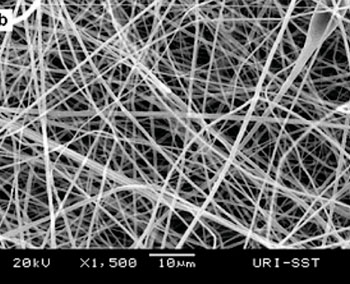Stem Cell Technology Helps Repair Heart Damage
By HospiMedica International staff writers
Posted on 27 Jan 2015
A novel minimally invasive nanotechnology solution could improve heart function in as little as two to four weeks. Posted on 27 Jan 2015
The BioGenerator stem cell device consists of two essential parts: a capsule made of a nanofibrous material that is woven into a scaffold using electrospinning technology, and human stem cells derived from adult bone marrow. Once prepared, the electrospun nanofibrous membrane capsule can either be stitched into the heart muscle wall, or injected into the heart muscle itself through a catheter. Both options are minimally invasive, do not require open heart surgery, and allow the heart to repair itself.

Image: Microstructure of electrospun polyester (Photo courtesy of NuVascular Technologies).
The BioGenerator works by controlling the dispersion of stem cells, while facilitating their removal when needed. But while the stem cells contained within the scaffold cannot escape, molecules such as proteins and growth factors derived from them can move through the membrane into the heart muscle, stimulating cardiac myocytes to grow and repair the damage within the damaged heart. The BioGenerator stem cell device is a product of NuVascular Technologies (Ashland, MA, USA), and was developed in conjunction with the Worcester Polytechnic Institute (WPI; Worcester, MA, USA).
“Our nanofibrous scaffold will ensure that the therapeutic benefit provided by stem cells will be localized directly to the damaged area of the heart,” said Matthew Phaneuf, BSc, founder and chief technical officer of NuVascular Technologies. “We are confident that our devices can provide a minimally invasive, highly effective treatment for heart disease that can actually reverse the damage, rather than providing a temporary solution that often comes with complications.”
Electrospinning is a method of electrostatically depositing polymer nanofibers onto an object. By applying high voltage to a liquid polymer solution—such as polyester or polyurethane—a narrow, microscopic jet of viscous polymer solution is drawn towards a grounded surface. The solvent rapidly evaporates, leaving a solid layer of polymer nanofibers deposited onto the collecting surface. The resulting materials have synergistic microstructural and biological benefits that hold numerous advantages over conventional woven and knitted textile materials.
Related Links:
NuVascular Technologies
Worcester Polytechnic Institute














